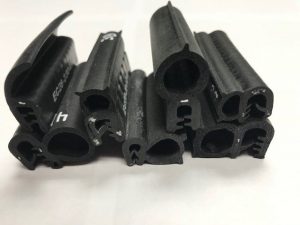Do you have questions about gasket compression? Elasto Proxy can help.
Why does gasket compression matter?
Gasket compression can support enclosure sealing or contribute to gasket failure. That’s because rubber gaskets are resilient, but only to a point. Compressing a rubber gasket within allowable limits forms a reliable seal. If the gasket is over-compressed, however, the rubber won’t rebound when the compressive stresses are removed. This creates a gap between the rubber gasket and the surface of the enclosure. Gaps cause leaks – and seals that leak won’t support your larger product designs.
What is the proper compression percentage for my gasket?
Rubber gaskets are compressed or squeezed by a percentage of their original size. A gasket that compresses too much or too little will not form a proper seal. The ideal compression percentage is 40, the maximum is 50, and the minimum is between 10 to 15.
What happens if the compression percentage is too much or too little?
If a gasket is compressed by more than 50 percent, it might not return to its original size. Here, it helps to think about a closed door. When a door is closed the gasket is compressed and fills the gap between the door and the door jamb. This seals out the environment. When the door is open. the gasket should return to its original size so that it can compress again when the door is closed.
If you over compress a door gasket, however, the rubber will not bounce back and can’t seal the gap. If the problem is that your gasket compression percentage is less than 10, you might not get contact between the two surfaces you’re trying to seal – and that will not keep out air, dust, or water.
What causes gasket compression problems?
In plastic and metal enclosures, over-compression can happen when a gasket is installed between metal parts that are held together by fasteners. If an operator over-torques the bolts or screws, the gasket may deform permanently. In other words, the rubber reaches compression set. When the bolts or screws loosen, gaps will form between the metal parts and the gasket material.
Applications with temperature changes and vibrations are especially susceptible to the loosening of fasteners. For example, mobile equipment and genset enclosures may be subjected to hot and cold temperatures that cause metal to expand and contract. They’re also exposed to vibrations from diesel engines. Under these dynamic conditions, even fasteners that are torqued properly may loosen.
Material relaxation poses gasket-related challenges, too. With enclosure sealing, a rubber that’s compressed will “push back” against the metal parts and fill the tiny gaps that would otherwise exist between the metal surfaces. Within an hour of the gasket’s installation, however, this reciprocating force may be only 75% of the original force. Enclosure seal failure may not happen but leakage can occur.
Compression-related problems aren’t limited to flat gaskets with fasteners either. Rubber profiles that attach to metal surfaces with tape or adhesives are also subject to over-compression. Examples include hatch seals on military vehicles and the dishwasher seals on appliances. With the latter example, the use of hot water and detergents can affect a rubber gasket’s material properties and degrade its performance.
How is gasket compression measured?
ASTM D395 is a standard from ASTM International that defines three different test methods (A, B, and C) for compression set in rubber materials. Typically, Test Method B is used. Unlike the other test methods, ASTM D395 B defines compression set as a percentage of the original deflection – the degree to which a sample of the gasket material is displaced under load.
ASTM D395 B testing begins by measuring the original thickness of a specimen. The sample is then put in a compressive device and compressed to 25% of its original height. Next, the device and the sample are put in an oven for either 22 or 70 hours (depending on the type of elastomer). The sample is then removed and allowed to cool for 30 minutes before its final thickness is measured.
For gasket designers, it’s important to note that ASTM D395 B accounts for compression at elevated temperatures. Yet it’s also important to understand that this testing is limited to an environment with constant compressive stress. That’s fine if you need a static seal, but what is you need a dynamic seal instead? Dynamic stressing also produces compression set, but there are some additional considerations.
What is compression set?
Material scientists calls the permanent deformation of the gasket material “compression set”, a term that’s widely used but not always fully understood. Engineers need to know the basics of compression set, but they also need to consider its limitations as a test method. With a metal or plastic enclosure, you need to account for the entire application environment, including variables such as temperature and vibration. Relaxation, a related phenomenon, is also associated with gasket compression.
Who helps engineers with gasket compression?
Do you need to replace enclosure seals where compression set has occurred? Do you need help choosing a rubber gasket material that will form a reliable seal and avoid over-compression? Elasto Proxy is an experienced gasket fabricator and creative problem-solver. For help with enclosure sealing, contact us.






